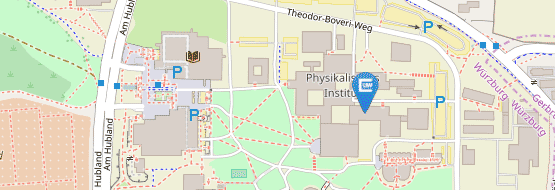Symmetry breaking ground state of kagome antiferromagnet and its Hida model
by Pratyay Ghosh
Time: Monday, 2nd October, 14:00
Place: TP1 Seminar room (M1.03.020)
Abstract:
The frustrated quantum antiferromagnets are known to disfavor magnetic ordering and
exhibit exotic low-temperature phases. Spin-1 kagome Heisenberg antiferromagnet (KHA)
is one such example where most theoretical works have predicted a gapped ground state.
Though, the detailed nature of the state is still debated mainly between the hexagonal sin-
glet solid (HSS) state and the trimerized singlet (TS) state. The TS state spontaneously
breaks the lattice symmetry by having more singlet weight on one set of triangles (all up
or all down) of the lattice. On the contrary, the HSS state breaks no symmetry of spin or
lattice type. Hida constructed HSS state inspired by a spin-1 kagome antiferromagnet can-
didate m-MPYNNBF4, which is a model of spin-1/2 antiferromagnetic hexagons (coupling
strength JA) coupled ferromagnetically (coupling strength JF ). We call it the Hida model.
The HSS state is constructed by rst forming the direct product of the (lowest energy) sin-
glet on every AFM hexagons (HS state), and then symmetrizing the pair of spins on every
FM bonds.
At rst, by doing a plaquette-triplon analysis (a low-energy bosonic mean-eld theory),
we investigate the ground state for a spin-1 KHA and nd it to be the TS state. Also,
with the introduction of second neighbor interactions, we discover the system to go into two
distinct ordered states (one of which was previously unknown). Now, for the Hida model,
at JF = 0, the HS state is the true ground state of the system. Here, by means of triplon
analysis and Schwinger boson mean-eld theory, we address the question of how at large
|JF|, the HS state (with uniform singlet amplitude), without becoming a HSS state, evolves
to the symmetry-breaking TS ground state. We nd the uniform HS state to rst undergo a
spontaneous dimerization at small JF . Then, at higher |JF|, this dimerized state go through
a second transition, under which the spin-1/2 pairs on FM bonds rapidly grows a spin-1
moment per FM bond, to result in the TS state of spin-1 KHA.
A Monte-Carlo study of three-dimensional chiral spin liquids in anisotropic hypernonagon Kitaev models
by Dr. Yasuyuki Kato
Time: 24.07.2017, 15:00
Abstract
The Kitaev model is an exactly-soluble quantum spin model with frustration. Although the original model was defined on a honeycomb lattice, the model has been extended to various tricoordinate lattices without losing the exact solubility. We analyze two different anisotropic limits of the Kitaev model on a three-dimensional lattice comprising nine-site elementary loops, which we call the hypernonagon lattice. In both cases, the effective Ising-type models retain the time-reversal symmetry, suggesting that the ground states are chiral spin liquids. Using Monte Carlo simulations that respect the local and global constraints on the Ising variables representing Z2 fluxes, we show that there is a first-order phase transition at a finite temperature in each case, but in a different manner.
Non-fermi liquids, fixed point collisions, and tensorial order in grey tin and in some popular field theories
by Prof. Igor Herbut
Place: TP1 Seminar room
Time: 14:15-15:15, Friday May 5th
Abstract
Abrikosov proposed in 1974 that a 3D electronic system with its fermi level at the point of quadratic band crossing, as in the (spin-orbit coupled) gray tin or mercury telluride, should represent the simplest non-fermi liquid, due to the common long-range Coulomb interaction between the particles. I will review this idea and discuss how a non-fermi liquid ground state may be unstable to ordering via the mechanism of "fixed-point collision". This mechanism, with its concomitant hierarchy of scales, may also be identified as the culprit behind the notorious dynamical chiral symmetry breaking in the three dimensional electrodynamics, known as the effective theory of several strongly interacting condensed matter systems and as a favorite toy model of particle theorists. Some further applications of the nematic order parameters, possibly relevant to gray tin or iridates, in the current search for higher-dimensional interacting field theories will also be mentioned.



